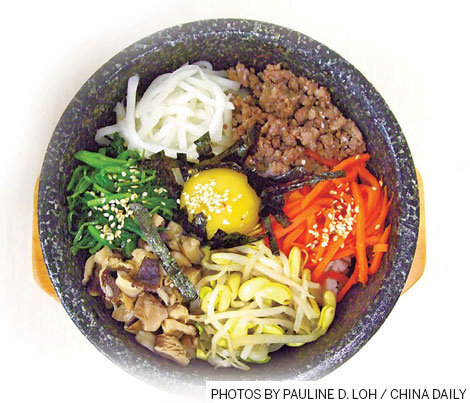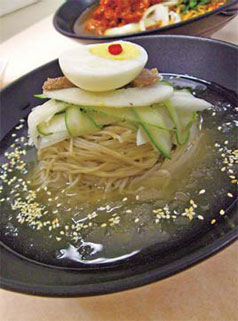Korean classics
Eating Korean is no novelty in China and there are plenty of places offering Korean food. But, nothing beats the adventure of exploring a different cuisine at home, says Pauline D. Loh.
The first time I was introduced to Korean cuisine by a colleague in Hong Kong I was frankly amazed by the number of little dishes that appeared on the table as appetizers. There were little dishes of cold tofu with sesame sauce, barely blanched bean sprouts served with chives, spinach smothered in a garlic sauce, braised chestnuts carved into perfect hexagons, salty anchovies lightly spiced with chilli paste ...
Those little dishes took up such a lot of space on the table that I wondered if there would be room for the main courses.
For a Chinese, eating Korean is a little familiar and yet a little strange. The ingredients are mostly recognizable, and we are eating with chopsticks and bowls - even though the chopsticks are mainly stainless steel, as are the bowls.
But here, the similarity ends. Korean food has its own unique characteristics and kitchen rules. For example, color plays a very important part, and there are five colors that each dish must have - black, red, yellow, green and white. There is also very little oil used.
This is most indicative in the classic Korean one-dish meal - the bibimbap. Often served in a hot stone bowl, the slightly sticky rice is covered by a neatly arranged topping of vegetables and meat that is a rainbow of flavors.
Typically, the green comes from blanched spinach topped with a dusting of white sesame seeds while the red (or rather orange) comes from braised grated carrots. The black is from the toasted seaweed strips used as garnish, along with a bright yellow egg yolk. More yellow and some white are reflected in soya bean sprouts. Finally, tender strips of meat colored brown or red by bean or chili paste complete the spectrum. More white, of course, is from the snowy rice hidden under the jewel tones of the topping.
Come to think of it, Korean cuisine is very healthy if you make the right choices. Bibimbap has more vegetables than meat, and you can quickly fulfill your daily quota of four helpings of vegetables in one dish. That is certainly the right idea, where flavored meat is used as seasoning rather than the highlight of the meal.
Of course, a bibimbap set often includes soup, usually miso flavored or a clear tofu soup, and little side dishes of kimchi and salted anchovies.
Another of my favorites is the Korean cold soba noodle. The chewy texture of Korean soba is very different from the Japanese version, which is less tactile.
Also, cold Korean soba is served with an icy and tart soup base that wakes up any taste buds gone sluggish.
Both classic Korean dishes are surprisingly easy to do, and perfect for entertaining on a cool autumn evening. True, there is a lot of preparation beforehand, but the pleasure of sharing such satisfying food makes up for the extra effort, don't you think?
If you have questions, feel free to e-mail me at paulined@chinadaily.com.cn.

Recipe |
Bibimbap Ingredients (serves 4):
1 small carrot, cut into thin strips
1 small radish, cut into thin strips
4 small bunches of spinach, washed and rinsed well
200g soya bean sprouts
4 egg yolks
1 sheet of toasted sushi seaweed, cut into strips
200g pork fillet, cut into thin strips
1 tbsp Korean hot chili paste
1 tbsp toasted sesame seeds
1 liter chicken stock
4 bowls of cooked rice
100g dried anchovies
1 tsp hot chili paste
1 tsp sesame seeds
1 pkt cabbage kimchi
Method:
1. Heat up the chicken stock and blanch the vegetables, starting with the spinach, then the carrots and then the radish. Blanch them all separately.
2. Blanch the spinach for three minutes and drain well. Gather them into bunches and trim into neat lengths. Divide into four portions.
3. Blanch the radish strips before you do the carrots so the chicken stock does not get discolored and tint the radish strips. Cook the radish strips for about four to five minutes. Drain and divide into four portions.
4. Finally, cook the carrot strips, drain and divide. Carrots need a very short cooking time, so cook according to your preference for a crunchier or softer vegetable.
5. Remove the tail from the soya bean sprouts and blanch very quickly. Divide into four portions.
6. Marinate the pork strips in the tablespoon of hot chili paste, and run them through hot oil. Toss them in a hot wok until they are cooked and tender. Divide into four portions.
7. Pick through the dried anchovies and split the fillets. Shallow fry the anchovies in a little oil and add the teaspoon of chili paste. Toss to coat. Add the sesame seeds and mix through.
8. Assemble the bibimbap. Arrange the blanched vegetables and a small portion of bean paste pork strips around the bowl, making sure there is color contrast among the various vegetables.
9. Place some seaweed strips in the middle of the bowl, and carefully slide an egg yolk on top of the seaweed. Serve the bibimbap at once.
10. To eat, mix up the various ingredients into a sort of rice and vegetable salad. The egg yolk will cook slightly in the hot rice and moisten the vegetables. Serve with small platters of anchovies and kimchi.

Recipe | Cold Soba Noodles
Ingredients (serves 4):
2 liters clear beef broth
1 5-cm knob of ginger
2 cloves garlic, thinly sliced
150 ml white vinegar
2 tbsp sugar
2 tsp soy sauce
1 cucumber, thinly sliced
1 nashi pear, peeled, then thinly sliced
2 hard-boiled eggs
8 thin slices of cooked beef shin
4 bunches of Korean soba noodles
Toasted sesame seeds for garnish
Method:
1. At least three hours or the day before, prepare the broth. It needs to be chilled until icy cold.
2. Combine beef broth, ginger, garlic, vinegar, sugar and soy sauce together and gently simmer for about 30 minutes. Strain and remove any scum floating on top.
3. Chill until very cold. I place my broth in the freezer for half an hour before serving so there are lumps of ice floating when I spoon it over the noodles.
4. Cook the noodles according to packet instructions and refresh under cold water to stop them cooking further. Divide into four bowls.
5. Arrange a pyramid of cucumber slices, pear slices and beef slices on top of the cold noodles. Top with half a hard boiled egg.
6. Just before serving, ladle over the chilled beef broth and garnish with toasted sesame seeds.
7. (Taste the beef broth before ladling over the noodles. If it is too concentrated, add some crushed ice to the soup. It will both dilute the flavors and add to the chill we treasure in this dish.)
















